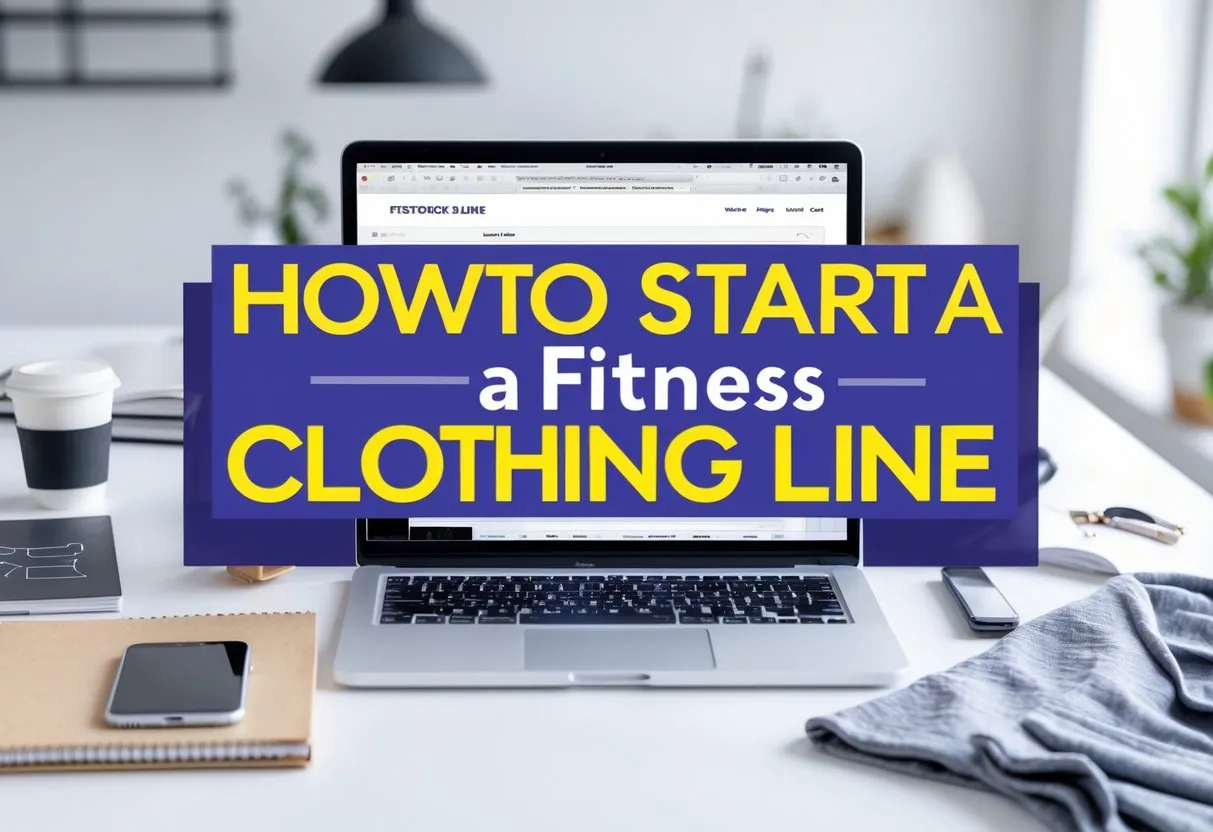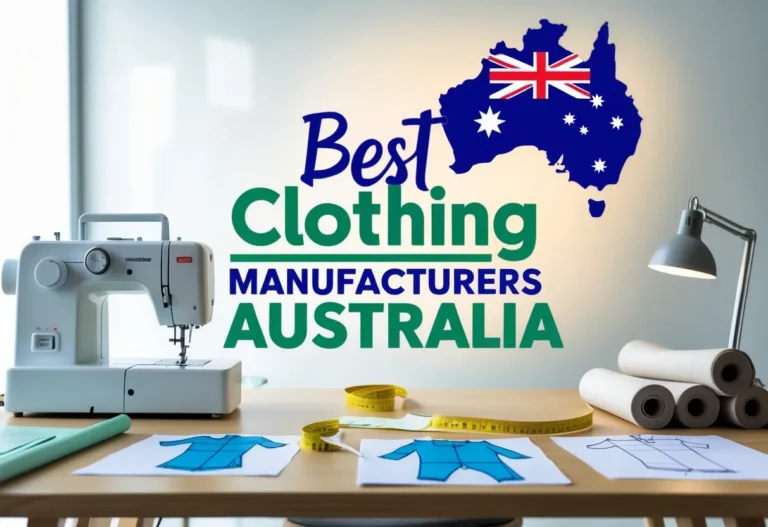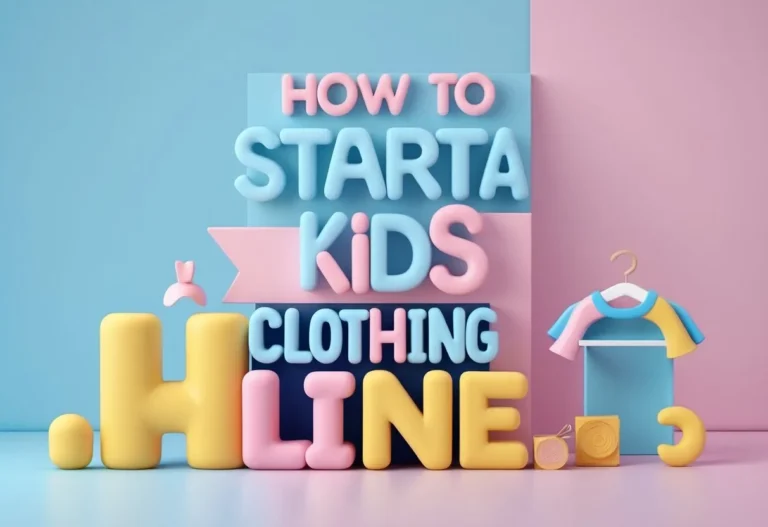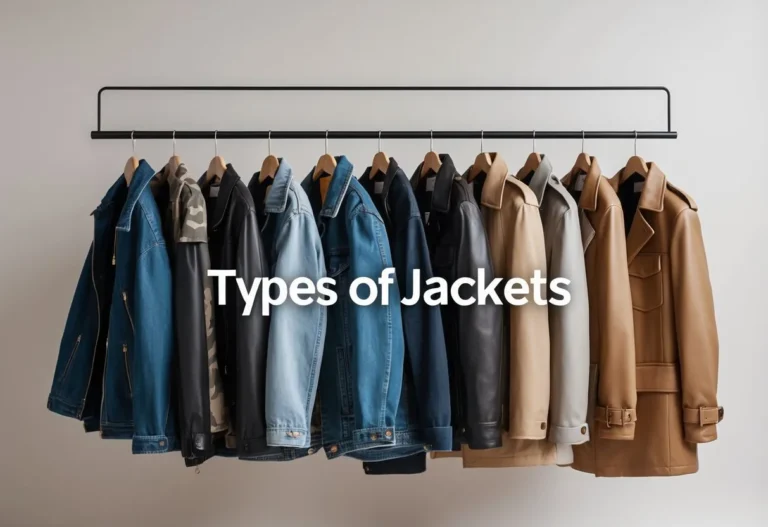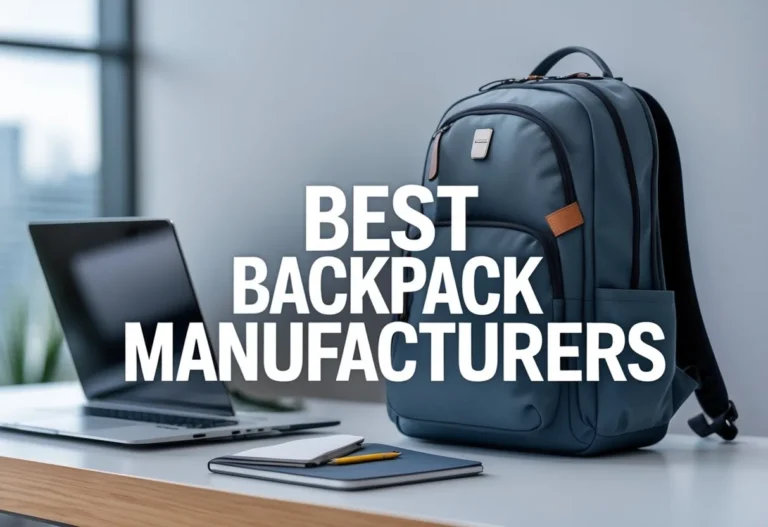How to Start a Fitness Clothing Line: Step-by-Step Guide
How to Start a Fitness Clothing Line is a promising business idea, especially as more people focus on health and style. To launch a successful fitness apparel brand, one must carefully research the market, design functional and appealing products, and build a strong presence both online and offline. Knowing the target customers and understanding competitors helps create a unique brand that stands out.
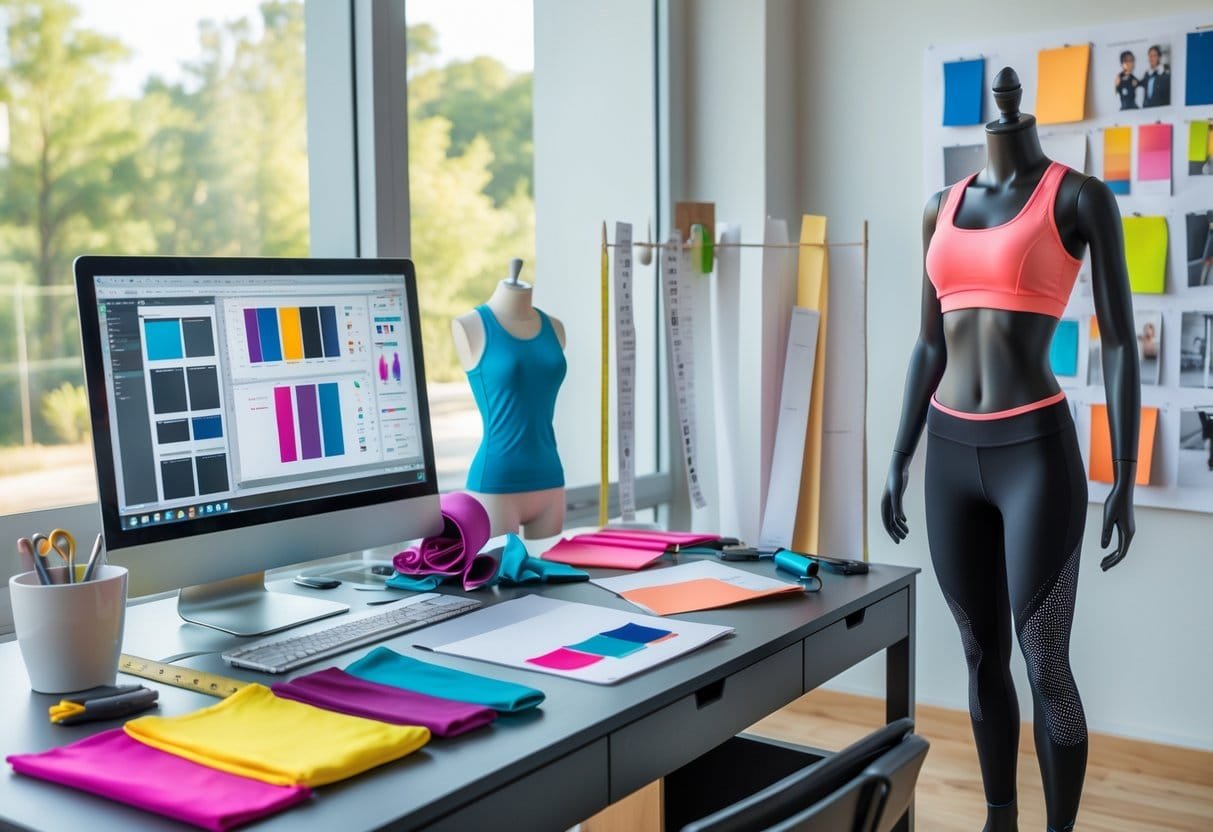
Creating a fitness clothing line involves more than just designing apparel. From legal steps like registering the business and securing permits to finding reliable manufacturers, each part is key to smooth operations. Marketing the brand well and managing finances wisely also play major roles in turning the idea into a profitable business.
Key Takeaways
- Research and plan to identify your target market and competition.
- Focus on product design, quality materials, and manufacturing.
- Build strong marketing and manage legal and financial tasks carefully.
Defining Your Fitness Clothing Brand
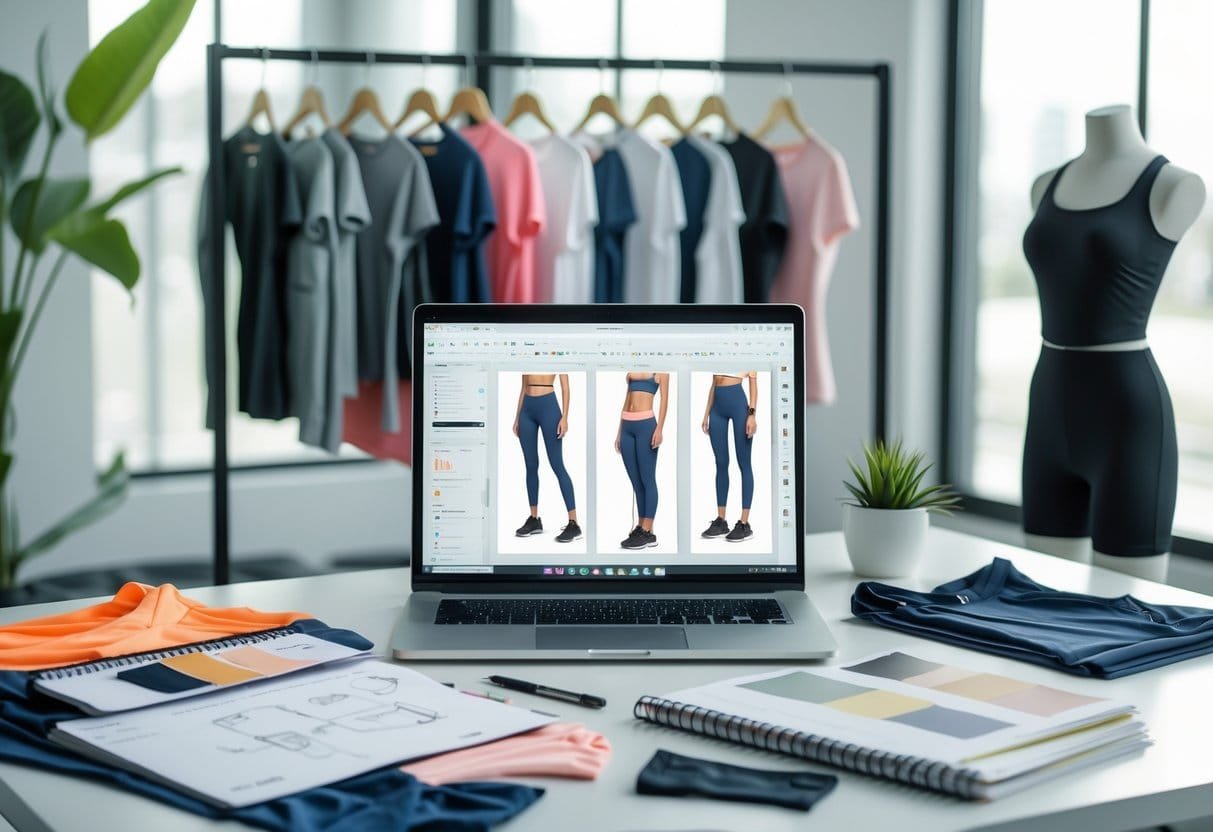
Creating a fitness clothing brand starts with carefully shaping what it stands for and who it will serve. This process includes deciding on a niche, crafting a distinctive identity, and selecting a memorable name and logo. Each part plays a vital role in how the brand connects with customers and stands out in a crowded market.
Identifying Your Niche and Target Audience
Focusing on a specific part of the fitness market helps the brand attract loyal customers. The niche might be yoga wear, running gear, or high-intensity training apparel. Narrowing this down makes it easier to meet the unique needs of buyers.
Understanding the target audience is crucial. Factors like age, gender, fitness level, and lifestyle guide product choices and marketing. For example, a brand targeting young runners will emphasize lightweight, breathable fabrics, while one for weightlifters may focus on durability and stretch. Defining this audience shapes everything from design to sales strategy.
Building a Strong Brand Identity
A fitness clothing brand’s identity is the combination of its values, look, and tone. It should clearly express what the brand stands for and why customers should choose it.
The brand’s message might highlight performance, comfort, sustainability, or empowerment. Visual elements include a consistent color palette, style, and imagery to create instant recognition. The tone—whether motivational, friendly, or technical—guides how the brand communicates in ads, social media, and customer service.
Together, these pieces build trust and help the brand create an emotional connection with its audience.
Choosing a Brand Name and Logo
A strong brand name is easy to remember, spell, and say. It should also be available as a website domain and on social media platforms to ensure consistent branding online.
The logo represents the brand visually and appears on clothing labels, the website, and marketing materials. A good logo is simple, flexible, and meaningful. Hiring a professional designer can help create a mark that suits the brand’s identity and appeals to its target customers.
Both the name and logo are key to building brand awareness and loyalty in the activewear market.
Conducting Market Research and Planning
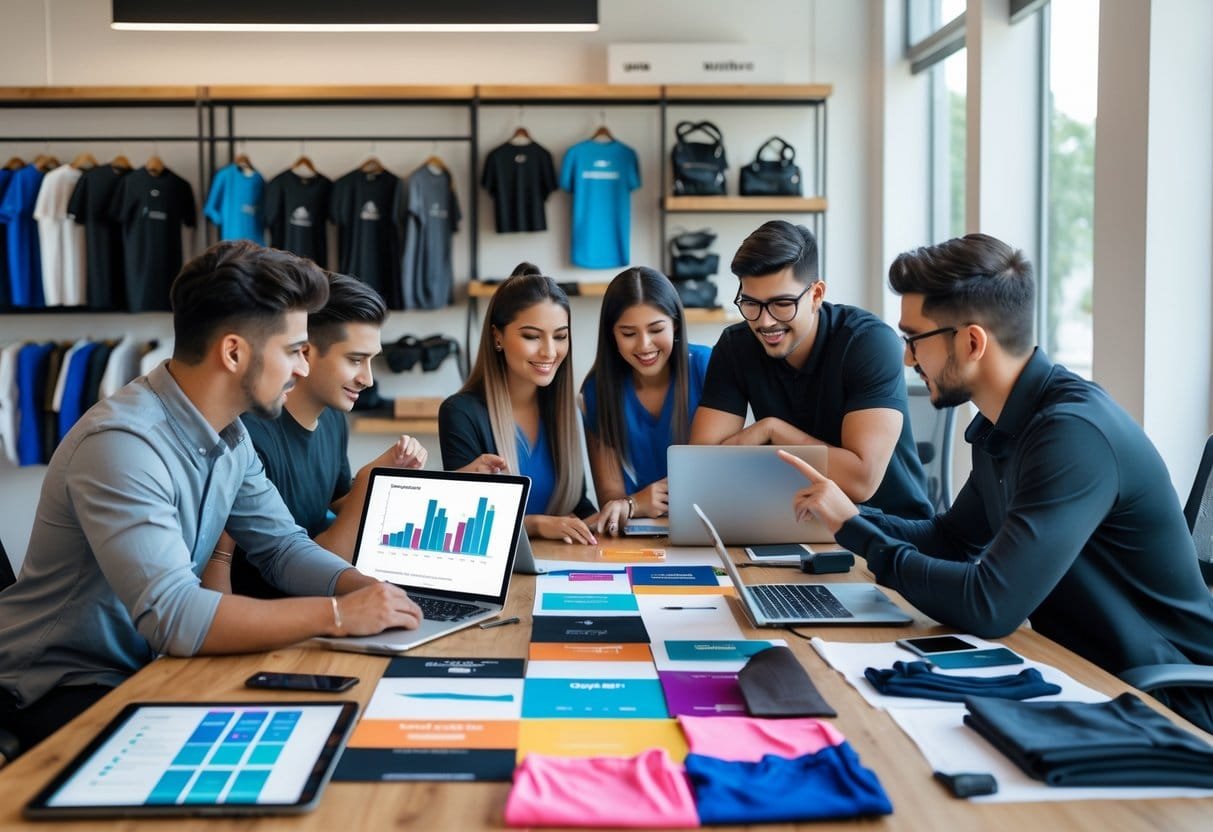
Starting a fitness clothing line requires understanding the market landscape and preparing a solid plan. This involves studying competitors, learning current trends, and setting clear business goals to guide decisions and growth.
Analyzing Competitors and Market Trends
Competitor analysis helps identify what works and where gaps exist. He or she should examine both local fitness stores and online brands. Key points include product styles, pricing, and customer experience.
They should track major players like Nike or Lululemon, but also niche brands focusing on specific sports or sustainable fabrics. Observing social media and customer reviews can reveal what buyers value most.
Market trends show rising demand for athleisure, eco-friendly materials, and styles favored by Millennials and Gen Z. The fitness apparel market, especially women’s activewear, is growing. Understanding these trends helps tailor the brand to consumer preferences and stand out.
Creating a Business Plan
A business plan outlines the route from idea to operation. It covers target customers, product types, marketing strategies, and financial projections.
Essential sections include:
- Market analysis: Identify potential customers and demand
- Product line: Define what will be offered, such as yoga pants or sports bras
- Marketing and sales: Plan how to attract and retain customers
- Financials: Include startup costs, pricing, and revenue expectations
A detailed plan guides every step and can help secure funding or partnerships. It also clarifies the brand’s unique value to customers and investors.
Setting Goals and Objectives
Goals provide direction and measurable benchmarks. They may include launching a website, reaching sales targets, or expanding the product range.
Objectives should be specific, measurable, achievable, relevant, and time-bound (SMART). Examples:
- Launch the first collection within six months
- Reach 1,000 online sales in the first year
- Build brand awareness through social media campaigns
Setting clear goals ensures the fitness clothing business stays focused. It also allows for tracking progress and adjusting strategies as needed.
Designing Your Fitness Apparel Collection
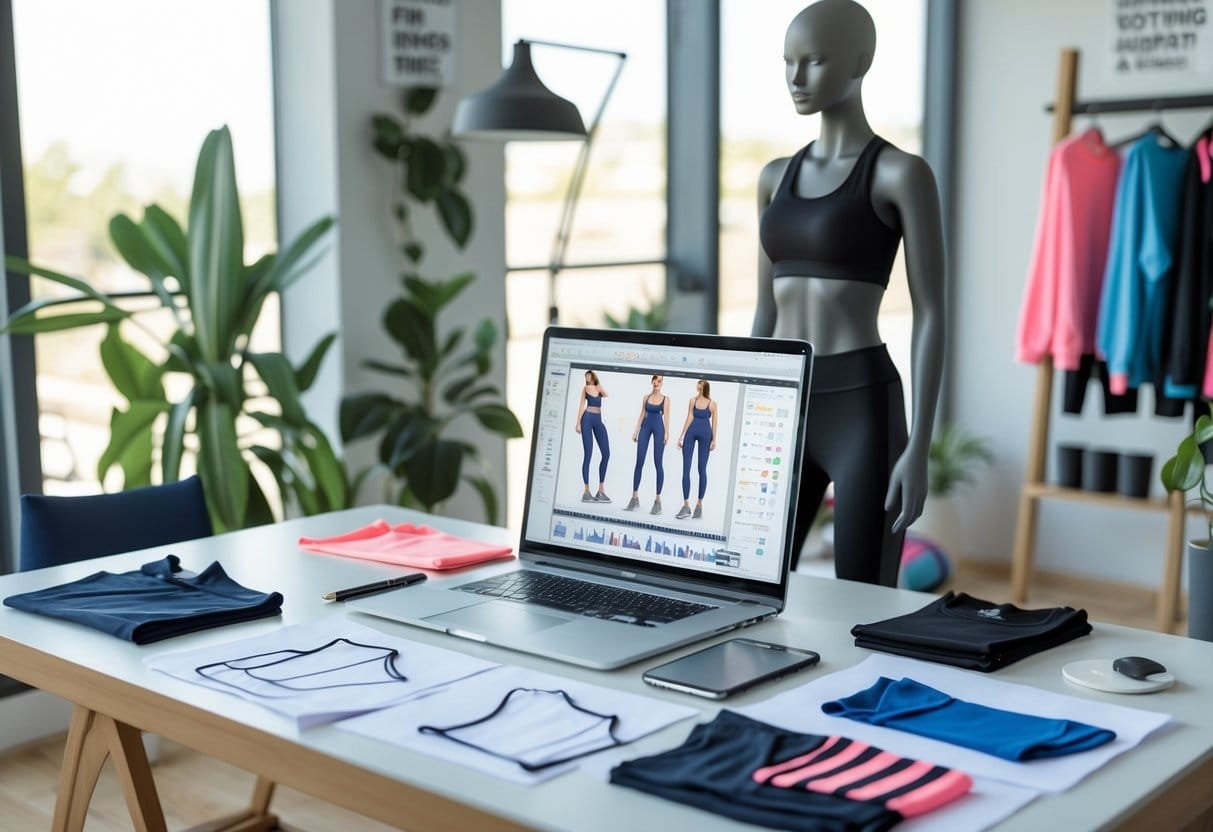
Creating a fitness apparel collection requires careful choice of products, fabrics, and detailed design instructions. Each decision affects quality, comfort, and appeal to the target customer. Clear planning helps turn ideas into a cohesive, functional collection.
Product Selection and Categories to Start a Fitness Clothing Line
Choosing which items to include depends on market needs and customer preferences. Key categories often include leggings, sports bras, tank tops, shorts, jackets, and hoodies. These cover both gym wear and athleisure styles.
He or she should focus on pieces that solve specific problems for the wearer, like compression wear for muscle support or moisture-wicking fabrics to stay dry. Starting with a small range, such as 10-15 pieces, helps manage production costs while testing the market.
Selecting complementary items builds a full collection. For example, pairing leggings with matching sports bras or adding versatile jackets and hoodies can attract customers looking for coordinated outfits.
Material and Fabric Choices to Start a Fitness Clothing Line
Fabric choice directly impacts comfort, performance, and sustainability. Performance fabrics like technical blends are popular for their stretch, breathability, and moisture-wicking qualities. Examples include:
- Nylon and spandex blends for stretch and shape retention
- Polyester with moisture-wicking treatment for sweat management
- Compression fabrics to improve circulation and support
Sustainable fabrics are increasingly important. Using recycled polyester or organic cotton appeals to eco-conscious buyers. These fabrics may cost more but can enhance brand value.
The feel and durability of the fabric must match the intended use. For example, heavier fleece is better for jackets, while lightweight, breathable fabric suits tank tops and shorts. Testing fabric samples early ensures the final product meets expectations.
Developing Tech Packs and Prototypes to Start a Fitness Clothing Line
Tech packs serve as detailed blueprints for manufacturers, outlining every feature and measurement of each product. They include design sketches, fabric specs, colors, sizing charts, and construction details.
This documentation ensures the factory understands exact requirements, reducing errors and delays. It also helps maintain consistent quality across production batches.
Prototyping turns designs into physical samples. Working closely with the supplier during this stage allows for adjustments to fit, fabric behavior, and construction. Multiple rounds of prototyping may be necessary before final production.
A well-prepared tech pack combined with thorough prototyping leads to products that reflect the original vision and perform well during use.
Sourcing Materials and Manufacturing
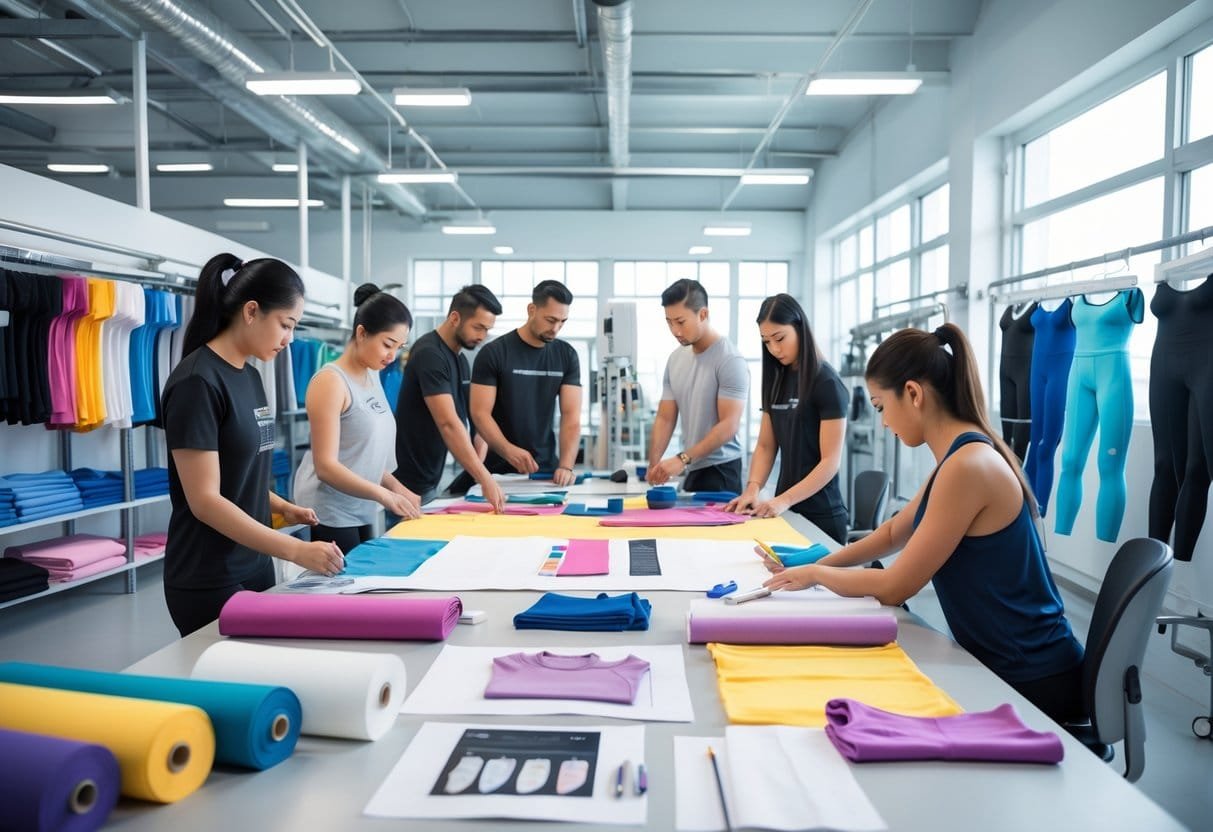
Starting a fitness clothing line means carefully selecting materials and choosing the best way to produce garments. This process involves finding trustworthy suppliers, deciding between different manufacturing methods, and managing costs tied to order sizes.
Finding Reliable Suppliers and Manufacturers
A fitness brand depends on strong partnerships with suppliers and manufacturers. Finding reliable suppliers means looking for those who provide high-quality performance fabrics like moisture-wicking polyester or stretchy spandex blends. Suppliers should also meet deadlines and offer consistent material quality.
Manufacturers must have experience in fitness apparel production. Brands often choose between domestic and overseas options. Domestic manufacturing can provide better quality control and faster communication but usually costs more. Overseas manufacturing may lower costs but requires strict vetting for quality and ethical standards.
Sampling and prototyping are critical. Brands should order samples before full production to check fabric feel, stitching, and fit. Quality control at every stage helps avoid mistakes and ensures the final product matches brand standards.
Understanding Production Option to Start a Fitness Clothing Line
Manufacturing options vary based on budget and control needs. Brands can choose:
- Domestic Manufacturing: More expensive but offers easier factory visits and faster adjustments.
- Overseas Manufacturing: Cost-effective but needs thorough research to ensure ethical labor and quality.
- Private Label: Buying ready-made activewear to add branding. This reduces design control but speeds up launch time.
Each option affects lead times, costs, and product uniqueness. Domestic production often suits smaller batches with high standards, while overseas is better for scaling up. Private label suits startups focusing on marketing rather than design.
Managing Minimum Order Quantities and Costs
Manufacturers typically require minimum order quantities (MOQs), which are the smallest batch sizes accepted. MOQs vary widely, often from 100 to 500 units per style or color. These can pose challenges for new brands with limited budgets.
Costs rise with MOQs and fabric choices. Brands should budget for raw materials, manufacturing, shipping, and quality control checks. Paying too little attention to MOQs risks either overspending on excess stock or settling for fewer product options.
Inventory management is essential to balance stock levels and cash flow. Brands often start with smaller MOQs or use private label options to reduce upfront costs. Negotiating with manufacturers on MOQs and payment terms can also help control expenses.
Building Your Online Presence and Store

Building an online presence starts with choosing the right tools and setting up your store properly. Clear, attractive product listings help customers find and buy your fitness apparel easily. Each step requires focus to create a professional and user-friendly shopping experience.
Choosing an E-Commerce Platform to Start a Fitness Clothing Line
Selecting a reliable e-commerce platform is key for a fitness clothing line. Popular options include Shopify, WooCommerce, and Squarespace. Shopify is excellent for those who want an easy-to-use, all-in-one solution with built-in payment processing and marketing tools. WooCommerce is a good choice if they prefer more control and use WordPress for their website. Squarespace offers sleek design templates and simple store management but fewer specialized features.
They should consider platform fees, customization options, ease of use, and scalability. For direct-to-consumer (DTC) brands, Shopify’s integrated tools for handling shipping and taxes make it a top choice. WooCommerce suits sellers wanting full site control and low costs but requires web hosting.
Setting Up Your Online Store to Start a Fitness Clothing Line
After selecting a platform, the next step is to set up the online store. This includes choosing a domain name, setting up payment methods, and organizing the navigation menu. Clear store categories help customers browse easily between tshirts, leggings, jackets, and accessories.
They must upload high-quality images and write clear product descriptions. Setting up trust signals like SSL certificates and easy return policies builds customer confidence. Integrating social media and email sign-ups supports ongoing marketing. For DTC models, setting up direct communication channels with customers enhances engagement and feedback.
Optimizing Product Listings to Start a Fitness Clothing Line
Product listings should be detailed, straightforward, and optimized for search engines. Titles need to include relevant keywords like “performance leggings” or “moisture-wicking tops” to improve visibility online.
Descriptions should explain the benefits and features, such as breathable fabric or compression fit, without extra fluff. Bullet points work well to highlight key details quickly.
Clear sizing charts reduce returns by helping customers choose the right fit. Adding multiple photos from different angles and featuring use cases helps buyers make decisions. Pricing and shipping information must be transparent. Well-optimized listings increase conversion rates and lower customer questions.
Marketing and Growing Your Brand

Building a fitness clothing line means reaching the right audience with clear messaging. The brand must communicate its unique value and connect with customers where they spend time online. Effective marketing balances visibility and loyalty through consistent efforts tailored to the brand’s identity and products.
Developing a Marketing Strategy
A strong marketing strategy starts with defining the brand’s identity and target audience. The brand should highlight what makes its fitness apparel different, such as sustainable materials or inclusive sizing. Setting clear goals—like increasing online sales or growing social media followers—helps focus efforts.
Research competitors to identify gaps and opportunities. A detailed plan should include key channels, messaging, and a budget. Tracking performance with analytics tools supports ongoing improvement. Consistency is crucial; all communications, from packaging to social media posts, must reflect the brand’s core message.
Social Media and Influencer Marketing
Social media platforms like Instagram and TikTok are essential for engaging fitness enthusiasts. Brands should post regularly, using high-quality photos and videos to showcase products in action.
Partnering with fitness influencers expands reach and builds trust. Influencers demonstrate how the clothing performs during workouts, making products relatable. Selecting influencers whose followers match the brand’s target market is key. Collaborating with brand ambassadors can further strengthen long-term loyalty and create authentic content that resonates widely.
Content and Email Marketing
Content marketing helps brands tell their story and provide value beyond selling products. Blog posts, workout tips, or behind-the-scenes videos build community and keep customers engaged.
Email marketing remains an effective tool for direct communication. Newsletters can share new launches, exclusive discounts, or fitness advice. Personalizing emails based on customer behavior encourages repeat purchases. Building an email list early and segmenting contacts ensures relevant messages reach interested audiences.
Paid Advertising and Promotions
Paid ads on social media and search engines like Google help attract targeted traffic quickly. Social media ads allow precise audience targeting based on interests, location, and behavior.
Clear calls to action and promotions—such as free shipping or limited-time discounts—boost conversion rates. Starting with a modest budget and testing different ads helps identify what works best. Monitoring ad performance through analytics enables the brand to optimize campaigns for higher return on investment.
Combining paid advertising with organic marketing tactics strengthens overall visibility and supports steady brand growth.
Operations, Legal, and Financial Management

Efficient operations, clear legal protections, and solid financial planning form the foundation of a successful fitness clothing line. Managing daily tasks, setting budgets, safeguarding designs, and building a reliable team ensure smooth growth and sustainable profits.
Setting Up Operations and Customer Service
Operations start with organizing inventory, order fulfillment, and supplier relations. Keeping accurate stock records prevents overselling and helps predict future needs. Using inventory management software can automate these tasks, reducing mistakes.
Customer service is vital for brand loyalty. Prompt responses to questions, easy returns, and clear communication increase satisfaction. Training staff on product details and handling complaints improves the shopping experience. Whether selling online or in stores, consistent service builds trust.
Reliable shipping and packaging practices also matter. Using quality materials protects products and reflects brand professionalism. Tracking orders and offering estimated delivery times minimize customer uncertainty and reduce complaints.
Budgeting and Pricing Strategy
Budgeting includes all startup costs like design, sampling, website development, and marketing. Typical startup expenses range from $50,000 to $100,000, with ongoing costs like fabric, advertising, and software subscriptions adding about $5,000 monthly.
Pricing should cover production, overhead, and profit margins. Research competitors’ price points to stay competitive while reflecting product quality. For example, sports bras and yoga pants may have different markups depending on materials and target customers.
A clear budgeting plan tracks income and expenses to avoid cash flow problems. Using accounting software helps control costs and generate reports for tax and growth planning. Separating business and personal finances simplifies bookkeeping and builds credibility with suppliers and investors.
Protecting Your Intellectual Property
Securing trademarks for business names and logos is crucial to prevent others from using the brand identity. Registering trademarks early protects against legal disputes and adds value to the company.
Fitness clothing lines should also protect unique designs and patterns. Copyrights or design patents guard original artwork and fabric prints. Maintaining detailed records of design creation dates supports claims if infringement occurs.
Labels, hangtags, and care instructions must comply with legal standards, including fiber content and country of origin disclosures. Proper labeling avoids regulatory fines and reassures customers about product authenticity.
Building a Support Team
Starting alone is possible, but a reliable support team enhances business efficiency. Key roles include an accountant to handle taxes and financial planning, and a customer service representative to maintain satisfaction.
Designers and marketers help develop products and reach target audiences. Hiring freelancers or part-time specialists controls costs initially and expands capacity during growth phases.
Legal advice ensures proper contracts and compliance. Even simple consultations prevent costly mistakes. Outsourcing certain tasks like social media management or order fulfillment can also free up time for core business activities.
Clear communication and defined roles strengthen the team’s effectiveness and align efforts with business goals.
Frequently Asked Questions
Starting a fitness clothing line involves careful planning, smart budgeting, and choosing reliable partners. Marketing and pricing strategies also play important roles in building a successful brand.
What are the initial steps to launching a fitness apparel brand?
The first step is researching the market to understand trends and customer needs. Designing a unique, functional product line follows.
Next, selecting a print-on-demand service or manufacturer helps avoid large upfront inventory costs. Setting up an online store is necessary to sell products.
What strategies can be employed to fund a fitness clothing line with minimum capital?
Using print-on-demand platforms lets brands start without buying inventory. This lowers initial costs and risks.
Crowdfunding or pre-selling products can raise funds before production. Many creators also use social media to build an audience early, making marketing more cost-effective.
Which manufacturers are recommended for producing quality fitness clothing?
Producers with experience in activewear and sustainable fabrics are preferred. Printful, Fourthwall, and Printify are popular for print-on-demand.
Brands focused on premium leggings or moisture-wicking fabrics should look for manufacturers offering these features and good customer reviews.
How can someone effectively market a new fitness clothing line?
Social media marketing on Instagram, TikTok, and YouTube is crucial. Sharing workout videos or styling tips with the apparel drives engagement.
Collaborating with fitness influencers or running targeted ads helps reach the right audience. Email marketing supports customer retention through updates and promotions.
What should be included in a business plan for a gym clothing company?
The plan must define the target market and unique selling points. It should include product designs, pricing strategy, and marketing plans.
Financial projections, supplier information, and operational details like shipping and customer service complete the plan. Clear goals help track progress.
What factors determine the profitability of a fitness apparel brand?
Profit depends on production cost, pricing, and customer demand. Premium products often have higher margins but may sell fewer units.
Niche markets like sustainable or sport-specific clothing can increase loyalty and pricing power. Efficient order fulfillment reduces expenses and improves profits.

